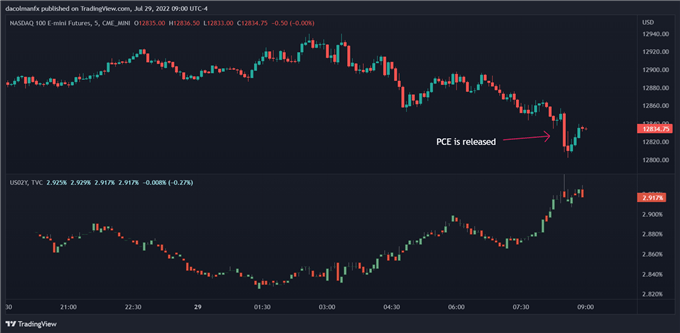[ad_1]
US PCE PRICE INDEX KEY POINTS:
- June U.S. consumer spending advances 1.1% versus 0.9% expected. Personal income at 0.6% m-o-m, slightly above expectations
- Core PCE, the Fed’s favorite inflation gauge, climbs 0.6% month-on-month and 4.8% from a year earlier, one tenth of a percent above forecasts
- Nasdaq 100 futures trim pre-market gains on bets stubbornly high inflation will prompt the Fed to continue raising rates
Most Read: US Gross Domestic Product Shrinks 0.9% in Second Quarter as Investment Slumps
The U.S. Bureau of Economic Analysis (BEA) released its latest report on personal consumption expenditures this morning. According to the agency, the June personal spending advanced 1.1% month-over-month versus the 0.9% expected – a sign that the American consumer remains resilient despite soaring consumer prices. Strong consumer spending at the end of the second quarter may help allay fears of a recession considering that household consumption is the main driver of U.S. economic activity.
Elsewhere, the PCE Price Index, which measures costs that people living in the U.S. pay for a variety of different items, surged 1.0% month-over-month and 6.8% year-over-year, the highest level since 1982. Meanwhile, the core PCE indicator, the Federal Reserve’s preferred inflation gauge that excludes food and energy and is used to make monetary policy decisions, advanced 0.6% on a seasonally adjusted basis, bringing the annual reading to 4.8% from 4.7% in May, one tenth of a percent above expectations, signaling inflationary pressures are struggling to cool in the country despite tighter financial conditions.
PCE REPORT DETAILS
Source: DailyFX Economic Calendar
Friday’s data from BEA was a mixed bag. Household spending grew at a sturdy pace in nominal terms, but the advance was mainly driven by rising prices. In any case, it is encouranging to see that the U.S. consumer remains healthy despite mounting challenges, including falling real income. This may help ease worries that household consumption is about to collapse, as we move through the second half of the year.
On the inflation front, there was no good news. The lack of directional improvement in the PCE index means that the Fed will have to continue raising rates in the coming months to slow demand in its effort to restore price stability. This suggests that a monetary policy pivot may not come until 2023, at the earliest.
Immediately after the personal consumption expenditures report crossed the wires, Nasdaq 100 futures contracts trimmed some pre-market gains as Treasury yields edged higher amid concerns that the U.S. central bank will not be able to slow the pace of interest rates hikes in an environment of strong inflationary forces. However, solid earnings from key technology companies, including Apple and Amazon, are helping blunt the impact from the the negative surprise on the macro front.
NASDAQ 100 FUTURES
Nasdaq 100 Chart Prepared Using TradingView
EDUCATION TOOLS FOR TRADERS
- Are you just getting started? Download the beginners’ guide for FX traders
- Would you like to know more about your trading personality? Take the DailyFX quiz and find out
- IG’s client positioning data provides valuable information on market sentiment. Get your free guide on how to use this powerful trading indicator here.
—Written by Diego Colman, Market Strategist for DailyFX
[ad_2]
Image and article originally from www.dailyfx.com. Read the original article here.

